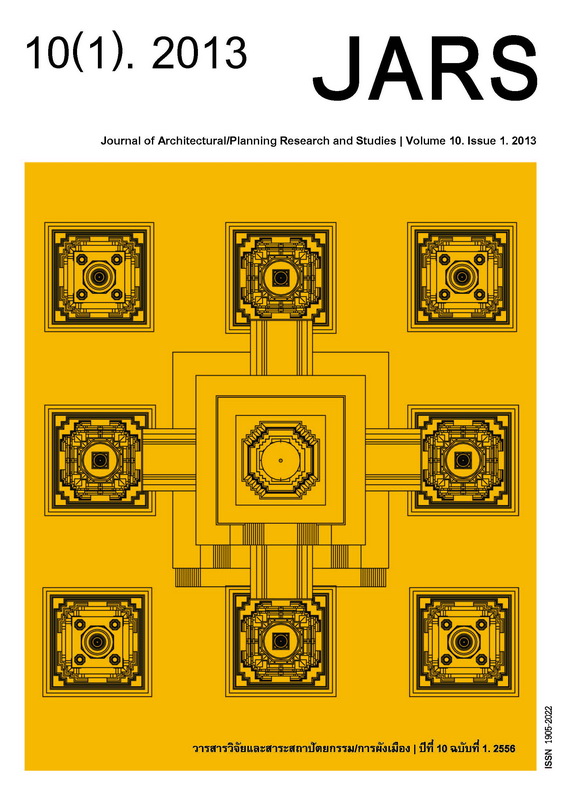Transmission of Modest Buildings with Cultural Significance: Case Study of Tai Dam’s Houses in U-Thong District, Suphanburi Province
Main Article Content
Abstract
The tortoise-shape houses are among the most prominent cultural identities of Tai Dam, an ethnic groupinhabiting in the river basin of Thailand. These houses are sometimes replicated or reproduced to demonstratethe past in traditional lifestyles of Tai Dam people. Various houses and granaries have been developed after theperiod of the tortoise-shape houses and still exist in Tai Dam communities. These Tai Dam’s houses integratedtraditional Tai Dam’s culture with Thai’s influence. At present, these houses with cultural significance areneglected or dismantled. The purpose of this research is to study the Tai Dam’s houses, which have beenevolved from tortoise-shape houses, with plural ethnic identity. The results of the research are useful for betterunderstanding of the dynamic nature of vernacular architecture. The study areas are in Sra-Yai-Som Tambonand vicinities in U-thong District, Suphanburi Province. Research methods include review of vernacular studiesand in-depth surveys. The finding reveals that building form and architectural elements have been developedinto 4 groups during the period of assimilation: 1) Tortoise-shaped houses with short cantilevered roof; 2) Gableroofhouse with traditional bamboo construction; 3) Gable-roof house with timber construction; and 4) Hip-roof(Panya style) house with timber construction. Architectural elements with minimum alteration are cruck-framecolumns and long cantilevered beams.
Downloads
Article Details

This work is licensed under a Creative Commons Attribution-NonCommercial-NoDerivatives 4.0 International License.
All material is licensed under the terms of the Creative Commons Attribution 4.0 International (CC-BY-NC-ND 4.0) License, unless otherwise stated. As such, authors are free to share, copy, and redistribute the material in any medium or format. The authors must give appropriate credit, provide a link to the license, and indicate if changes were made. The authors may do so in any reasonable manner, but not in any way that suggests the licensor endorses you or your use. The authors may not use the material for commercial purposes. If the authors remix, transform, or build upon the material, they may not distribute the modified material, unless permission is obtained from JARS. Final, accepted versions of the paper may be posted on third party repositories, provided appropriate acknowledgement to the original source is clearly noted.
References
Buranasompop, T., Shinawatra, W., Vonglodjanaporn, C., Samantarat, S., Poriprasert, T. & Charoensilp, E. et al. (2003). โครงการรักษาเอกลักษณ์สถาปัตยกรรมท้องถิ่นและสิ่งแวดล้อมเพื่อดึงดูดนักท่องเที่ยว จ. สุพรรณบุรี [The
conservation project of vernacular architecture and environment for tourist attraction]. Bangkok, Thailand: NSP Printing.
Burutpat, S. (1997). สารานุกรมกลุ่มชาติพันธุ์: ไทยโซ่ง [Encyclopedia of ethnic groups in Thailand: Thai Song Dam]. Bangkok, Thailand: Sahathammic.
Chaturawong, C. (1997). เรือนไทดำา: กรณีศึกษาเพชรบุรี [Tai Dam: A case study in Pethchaburi]. Master of Architecture Thesis, Faculty of Architecture, Chulalongkorn University, Bangkok, Thailand.
Inpuntung, V. (2012). เรือนลาวโซ่ง: การกลายรูปในรอบสองศตวรรษ [Lao-Song house: Transformation in two centuries]. Bangkok, Thailand: Usakaney.
Kirdsiri, K. (2011). ภูมิหลังการตั้งถิ่นฐานกลุ่มชาติพันธุ์ไท-ลาว และการเคลื่อนย้ายสู่ประเทศไทย [Historical background of Tai-Lao settlement and movement to Thailand]. Na Jua: Journal of the Faculty of Architecture, Silpakorn University, 7(July-August), 83-130.
Pinijvarasin, W. (2003). ความภูมิใจในตน: การธำารงของบ้านและเรือนไทยพื้นถิ่น [Pride of self: Sustaining of Thai vernacular house]. Proceedings of Current: Reflection of Society – Silpakorn Architectural Discourse 2003: 3rd Mini Symposium, Bangkok, 18-19 March 2003, 2.1-2.11.
Punpairoj, P. (2011). ไทดำารำาพันถึงเรือนกระดองเต่า: จากขุนเขาเมืองแถงสู่ลุ่มน้ำาภาคกลางของไทย [Tai Dum’s longing for Tortoise Shape Houses: From highland in Muang Thaeng to river basin of Thailand]. Journal of Architectural/Planning Research and Studies, 8(1), 21-34.
Sribusara, M. (1987). ไทยดำารำาพัน [Tai Dam’s longing]. Bangkok, Thailand: Bhannakij Publishing.


